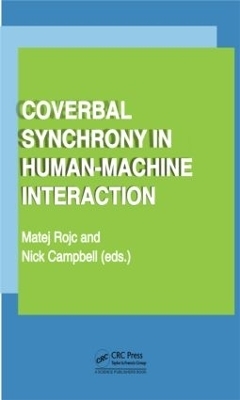
Coverbal Synchrony in Human-Machine Interaction
Seiten
2013
Crc Press Inc (Verlag)
978-1-4665-9825-6 (ISBN)
Crc Press Inc (Verlag)
978-1-4665-9825-6 (ISBN)
Embodied conversational agents (ECA) and speech-based human–machine interfaces can together represent more advanced and more natural human–machine interaction. Fusion of both topics is a challenging agenda in research and production spheres. The important goal of human–machine interfaces is to provide content or functionality in the form of a dialog resembling face-to-face conversations. All natural interfaces strive to exploit and use different communication strategies that provide additional meaning to the content, whether they are human–machine interfaces for controlling an application or different ECA-based human–machine interfaces directly simulating face-to-face conversation.
Coverbal Synchrony in Human-Machine Interaction presents state-of-the-art concepts of advanced environment-independent multimodal human–machine interfaces that can be used in different contexts, ranging from simple multimodal web-browsers (for example, multimodal content reader) to more complex multimodal human–machine interfaces for ambient intelligent environments (such as supportive environments for elderly and agent-guided household environments). They can also be used in different computing environments—from pervasive computing to desktop environments. Within these concepts, the contributors discuss several communication strategies, used to provide different aspects of human–machine interaction.
Coverbal Synchrony in Human-Machine Interaction presents state-of-the-art concepts of advanced environment-independent multimodal human–machine interfaces that can be used in different contexts, ranging from simple multimodal web-browsers (for example, multimodal content reader) to more complex multimodal human–machine interfaces for ambient intelligent environments (such as supportive environments for elderly and agent-guided household environments). They can also be used in different computing environments—from pervasive computing to desktop environments. Within these concepts, the contributors discuss several communication strategies, used to provide different aspects of human–machine interaction.
Matej Rojc, Nick Campbell
Section 1: Human-human interaction and communicative behavior. Section 2: Personality, affect, language-affect, emotions and expressivity. Section 3: Behaviour analysis, face analysis, gesture analysis, non-verbal communicative behaviour analysis, annotations. Section 4: Behaviour generation, gesture generation, synthetic behaviour animation, gaze, and description languages. Section 5: Animation, conversational agent design and evaluation. Section 6: Multimodal interfaces, multimodal fusion, multimodal output, visualization of synthetic speech, TTS visualization, and multimodal speaker conversion.
| Verlagsort | Bosa Roca |
|---|---|
| Sprache | englisch |
| Maße | 156 x 234 mm |
| Gewicht | 725 g |
| Themenwelt | Informatik ► Software Entwicklung ► User Interfaces (HCI) |
| Mathematik / Informatik ► Informatik ► Theorie / Studium | |
| Technik ► Elektrotechnik / Energietechnik | |
| Technik ► Umwelttechnik / Biotechnologie | |
| ISBN-10 | 1-4665-9825-5 / 1466598255 |
| ISBN-13 | 978-1-4665-9825-6 / 9781466598256 |
| Zustand | Neuware |
| Haben Sie eine Frage zum Produkt? |
Mehr entdecken
aus dem Bereich
aus dem Bereich
Aus- und Weiterbildung nach iSAQB-Standard zum Certified Professional …
Buch | Hardcover (2023)
dpunkt Verlag
CHF 48,85
Lean UX und Design Thinking: Teambasierte Entwicklung …
Buch | Hardcover (2022)
dpunkt (Verlag)
CHF 48,85
Wissensverarbeitung - Neuronale Netze
Buch | Hardcover (2023)
Carl Hanser (Verlag)
CHF 48,95


